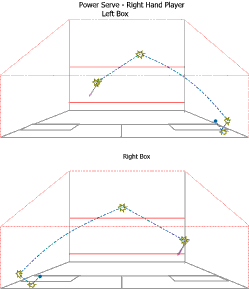The Squash Serve
- The Squash Serve is the only time in the game when a player has total control over the shot
- The receiver must attempt to ensure that they do not allow the server to gain the initiative.
- The Squash serve should be varied to prevent an opponent from "getting onto" the serve.
Stance and Ball Toss
More Pics...Serve Right Box Feet positionLeft box service position | ||||||||||||
Lob Serve
More on Lob Serve
|
| Good | Bad |
| The lob serve Is going over my opponent's head | The lob serve is too low |
| Is forcing a weak return | My serve is being attacked |
| Is allowing me to get to the middle of the court | My serve is preventing from moving out of the service box |
| Is soft and dying in the back of the court | My serve is rebounding into the middle of the court |
| My hard/power serve is forcing an error | The serve keeps going out of court |
Hard Serve or Power Serve

- The power serve is good for a change of tactics.
- This serve can becomes predictable when served continually.
- Adjust the target points to counteract the opponent's strengths, eg depending on the position the opponent stands to return the serve.
More on Hard Serve
 Squashgame Gold: Advanced Text and Video Content
Squashgame Gold: Advanced Text and Video Content
More on Hard/Power Serve
Key Points:
- Start the serve with a full backswing
- The hard serve resembles the serve of a tennis player.
- Strike the ball slightly above head height.
- Toss the ball relatively high and hit through the ball with an open face racket. Aim a racket head above the cut line.
- Change your target points according to the strengths of your opponent.
- Try to hit the side wall nick at the back of the service box.
- Aim higher on the side wall for the strong volleyer
- Hit it at or behind the opponent as a change (as a surprise).
- The power serve should always hit the side wall except if aimed at or behind the opponent.
- Move quickly to the T as your time is limited in comparison to the lob serve.
Backhand Serve from Righthand Box

A backhand serve from the right hand service box can be very effective.
It can be served as a Power Serve or Lob Serve.
The closer the target on the front wall is to the side wall, the lesser the angle of the rebound, making the ball follow closer along the side wall, making the return more difficult to attack.
It can be served as a Power Serve or Lob Serve.
The closer the target on the front wall is to the side wall, the lesser the angle of the rebound, making the ball follow closer along the side wall, making the return more difficult to attack.
More on Serve Basics
 Squashgame Gold: Advanced Text and Video Content
Squashgame Gold: Advanced Text and Video Content
More on Serve Basics
- Serving is a closed skill - the server has complete control over the shot including ball toss, racket swing and stance.
- It is the only case where a consistent technique can be practised, then repeated in a match.
- It gives the server the opportunity to put the opponent on the defensive.
- The softer the ball is hit on the serve, the higher the target on the front wall should be.
More on Stance & Ball Toss
More on Stance & Ball Toss
- It is important to be able to comfortably hit a lob and hard serve and get to the T quickly after serving.
- A number of positions can satisfy these criteria.
- Keeping to the front of the Service box helps get more height on the lob serve and gives the opponent less time to position themselves to return a hard serve.
- Move with the serve towards the T.
- Try to develop a stance and service style which allows either a power serve or a lob serve from the same basic action - this enables the server to disguise the serve.
Backhand Serve from Right Box
Especially effective for right handed players
A backhand serve is generally more effective from the forehand service box. Why?
- As it decreases the angle of the rebound of the ball from the front wall, thus making the ball travel much closer to the side wall.
Why is this significant?
- Because the ball is closer to the side wall at around the service box and the person returning the serve has to be ready to move into position earlier, and preferably take the serve before it strikes the side wall.
Video Resources
Video clip Basic Serves
Power Serve
The power serve is very similar to an attacking volley to length.
To get the power in the serve the ball toss needs to be about as high as the cutline, which in turn gives the downwards trajectory of the ball.
Video Resources
Support Squashgame
Support us here at Squashgame.info! If you think we helped you, please consider our Squash Shop when purchasing or make a small contribution.
